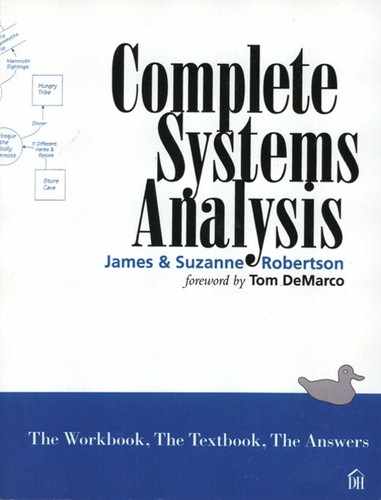3.8. Review: Modeling an Event-Response
Sample Event-Response Model
Compare your event-response process model for event 9 New agency wants to do business with Figure 3.8.1.

Figure 3.8.1: These are the data stores and processes that currently respond to event 9. The numbers enclosed in asterisks are those of the process in the current physical model. They are included to make it easier for you to relate this model to the diagrams in the current physical model.
Look at process 3.8 ASSIGN AGENCIES TO EXECUTIVE. Every time a new agency applies to do business with Piccadilly, a Sales Department clerk checks the register to find a sales executive who is available to deal with the new agency, and writes the new agency’s name next to the executive’s name. The clerk adds the new agency to the AGENCY REGISTER, generates a NEW AGENCY FORM, and sends it to the Computer Department.
In the Computer Department, process 1.7 is carried out when the operator enters information about the new agency into the computer system. Process 1.6 UPDATE AGENCY FILE is part of a computer program. It records the new agency in the AGENCY ACCOUNTS FILE.
Your event-response model brings together all the pieces by following the data flows through the system and identifying all the processes, data flows, and data stores that respond to an event. Make sure that your model is substantially the same as the sample. The next stage is to refine the model so that it contains only essential processes and data.
 Ski Patrol
Ski Patrol
If you had trouble isolating the responses to this event, keep in mind that the context of the response is bounded by terminators and data stores. This particular event is triggered by the data flow NEW AGENCY. Once it arrives at the context of the system, you model the system’s response by following the data flows until they are either stored or sent to a terminator. In this event-response, data flows are stored in SALES EXECUTIVE REGISTER and AGENCY REGISTER. That means the end of the line in that direction. However, the flow NEW AGENCY FORM went off for more processing, so you had to follow the trail to the Computer Department. Eventually, the chain of processes ended when the data flow was stored in AGENCY ACCOUNTS FILE. There are no flows going back to the terminator, so there is nothing left for you to follow.
If you missed some processes, you need to remember that the response to an event continues until all the data flows have been resolved. It doesn’t matter that the processes take place in different geographical locations, nor that the implementation may delay this continuous processing. The computer operator may decide to wait until after lunch to enter the new agency information, but there is no essential policy to contradict the notion of continuous processing until the response has finished.
Note that the data flow SALES EXECUTIVE NAME from bubble 3.6 into 3.8 is part of the response to another event, and so is not shown in Figure 3.8.1. Although event 9 does use the data element SALES EXECUTIVE NAME, it gets it from the data store called SALES EXECUTIVE REGISTER, which contains the names of all the sales executives employed by Piccadilly. The physical partitioning of the current system means that parts of two event-responses have been bundled together into one process. When you model the response to event 8 Personnel hires a sales executive, you will discover that the data flow SALES EXECUTIVE NAME will be included as part of the response to that event.
We took the easy way and built this model in two stages. If you built a model that included only essential stored data and no implementation-dependent processes, you should compare your answer with the one in Chapter 3.9.
If the ![]() Ski Patrol has not provided all the help you need, we suggest you work through Chapter 2.11 Event-Response Models before returning to the Piccadilly Project.
Ski Patrol has not provided all the help you need, we suggest you work through Chapter 2.11 Event-Response Models before returning to the Piccadilly Project.
